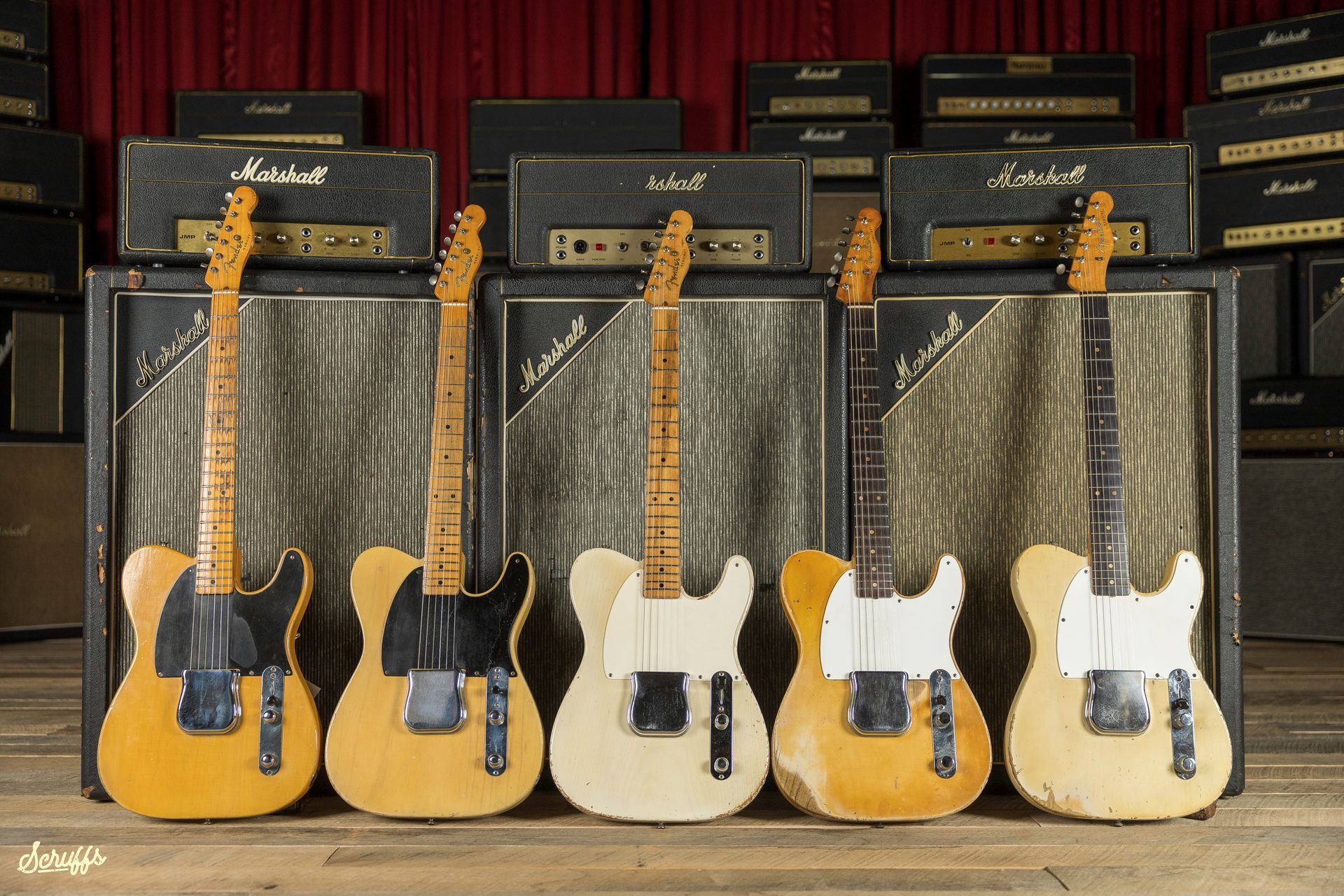Vintage Fender Esquires & Marshall Amps: A Rare Collection

It’s funny how things tend to come in clusters. The old “when it rains, it pours” adage definitely applied when we here at Scruff’s had the rare fortune of having five vintage Fender Esquire model guitars in stock at the same time.
These five incredible instruments cover almost all of the distinct historic changes in the first 15 years or so of this model’s history.
All the way to the left is a 1952 model, distinguished by its use of slot head screws throughout. A lightweight guitar (none of these five guitars is much over 7 lbs) with a big, comfortable neck and a nice, deep orange patina.
Next in line is a 1953 model Esquire. It seems to us that ‘53 was the year Fender Teles and Esquires became really consistent. While neck sizes, weight, and even the tone can vary quite a bit in earlier years, by 1953 necks are typically medium big with a tiny hint of “V” to their shape and generally little taper from the first to the twelfth fret. Screws are now all Phillips head.
Next to the ‘53 is a ‘55 model Esquire. Gone is the black bakelite pickguard that made way to this single ply white guard in the second half of 1954. The bridge plate no longer carries the serial number. It is now on the neck plate.
Do you have a vintage Fender Esquire or Telecaster that you are interested in selling? Click here!

The finish is a much more pale off-white translucent blonde. The neck shape is medium big and round. This guitar is from the earlier part of 1955 and still sports essentially the same flat pole pickup as the blackguards. Later on in 1955 the D and G magnet pole pieces would be raised to improve string balance (not that string balance was ever an issue with the flat pole pickups).
To the right of the 1955 Esquire is a 1960 model. It represents what could be considered the most significant step in the evolution of not just this model, but the entire Fender line up. 1958 saw the introduction of the rosewood fingerboard. All Fender guitars prior had a one piece maple neck. When they switched to rosewood fingerboards, they glued a thick slab of Brazilian rosewood to a flat maple blank, hence the moniker “slab board neck”.
These early slab board necks can be surprisingly small and thin at the first fret, with a substantial taper in thickness towards the body. From 1958/1959 the neck gradually became a bit fuller again, with the last slab board necks in early to mid ‘62 generally being the biggest.
Speaking of which, in the second half of 1962 Fender changed neck construction yet again and abandoned the slab board (except, interestingly for they student models MusicMaster and DuoSonic). Instead they introduced what’s become known as a “curved board”, or “veneer board” neck. As the name implies, the maple neck base has a curved fingerboard side, with a matching, much thinner rosewood fingerboard glued on top of it. This can be seen by either looking at the headstock or butt end of the neck.
Representing this era is the 1963 model Esquire at the right hand side of this lineup.
Behind the guitars are three 1966 era “pinstripe” 1x18 Marshall speaker cabinets. We here at Scruff’s happen to think these are some of the coolest looking cabs ever made.
The proportions and the corner logos just do it for us. Equipped with huge spider-framed Celestion 100 Watt G18 speakers, these cabs were meant for bass guitar, and they sound rather spectacular in that application. What is surprising is how good they sound for guitar as well!
On top of the cabs are two 1970 Marshal Lead and Bass amplifiers as well as an impossibly rare 1967 Marshall 20 Amplifier. These amps are equipped with a pair of cathode biased EL84 power tubes for around 20 Watts of power and deliver all of the legendary vintage Marshall tone at less-than-earsplitting volume levels.
Do you have a vintage Fender Esquire or Telecaster that you are interested in selling? Click here!






